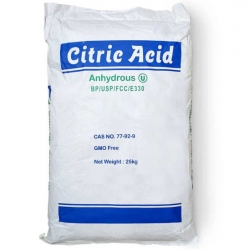Citric Acid :
Citric acid is an alpha-hydroxy tricarboxylic acid found abundantly in lemons, hence its name. It is a weak acid that plays a significant role in biochemistry as a metabolite in the Krebs cycle, a major metabolic pathway in all aerobic organisms.
More than a million tons of citric acid are industrially produced each year. It is widely used as a flavor enhancer, pH regulator in food, and as a chelating agent.
Application:
Food :
- Citric acid is a food additive (E330) industrially prepared by fungal fermentation and used in the food industry as an acidulant (souring agent), acidity regulator, leavening agent, and in flavor compositions (FEMA/GRAS number 2306).
- E330 is biosynthesized by microorganisms (fungi like Aspergillus niger) grown on a substrate usually containing molasses and/or glucose. These microorganisms may have been genetically modified to increase yield. The glucose can be derived from cornstarch, making it genetically modified. The potential use of genetically modified corn in the production of the food additive E330, without being labeled on the final product, was revealed in the documentary film "Food."
- In carbonated beverages, it appears as magnesium citrate Mg3(C6H5O7)2, 4H2O.
Medicine :
Cosmetic and pharmaceutical products :
- Citrate binds to blood calcium, which is essential, among other things, for blood clotting. This accounts for its anticoagulant properties, used in laboratories and for preserving blood products.
- Citrate is used in continuous renal replacement therapy as a regional anticoagulant in the purification circuit and especially the filter. This property is based on the chelation of ionized calcium, necessitating additional calcium administration.
- Citrate is also used as potassium or sodium citrate to alkalinize urine and prevent urinary stones, especially in cases of hypocitraturia where their use reduces the risk of recurrence of calcium lithiasis by inhibiting the growth of calcium oxalate and calcium phosphate stones. However, due to its side effects, this treatment is poorly tolerated in the long term, and often two glasses of orange juice per day are preferred.
Other :
- Rust reduction.
- In masonry, as an additive to quick-setting cement when there's a need to slow its setting time, especially on hot days where it might set almost instantly (refer to Vicat's technical documentation for Tempo product).
- Craft dough making.
- Fungicide, bactericide, anti-algae (combatting lichens).
- Complexing agent for iron in wines to delay ferric casse.
- Descaling agent for coffee makers.
- Used as a stop bath in analog photography.
- For diluting heroin (risk reduction).
- Organic citrates (e.g., triethyl citrate/acetylcitrate, tributyl): safe plasticizers with a favorable toxicity profile for plastics.
- Food and pharmaceutical industries.
- Confectionery.
- Effervescent salts (carbonated beverages).
- Oenology (wine treatment).
- Antioxidants for fatty substances.
- Metal ion sequestrant.
- Coolant cleaner in automotive mechanics.
Packaging:
25 Kg bag.





